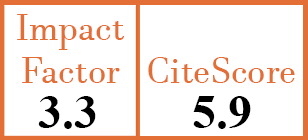Full Papers
Circulating microRNAs associated with tumour necrosis factor or fibloblast-like synoviocyte predict cartilage damage in early rheumatoid arthritis treated with methotrexate plus adalimumab: a subanalysis of the MIRACLE study
Y. Hosokawa1, Y. Yoshida2, H. Tamai3, S. Hirata4, K. Ikeda5, T. Miyamoto6, H. Taguchi7, C.-F. Kuo8, K. Shin9, K. Izumi10, Y. Kondo11, H. Yasuoka12, M. Kuwana13, T. Ishii14, H. Kameda15, T. Kojima16, M. Mori17, Y. Sato18, W.-C. Tsai19, T. Takeuchi20, Y. Kaneko21
Collaborator/s: Y. Okano1, S. Sato2, T. Gono3, K. Yoshimoto4, I.A. Choi5, S.-H. Park6, M.-Y. Weng7, Y.J. Lee8, J. Kim9, H.J. Baek10, P.-N. Hsu11, C.-M. Huang12, T.-T. Cheng13, W.-Y. Sung14
- Department of Clinical Immunology and Rheumatology, Hiroshima University Hospital, Japan.
- Department of Clinical Immunology and Rheumatology, Hiroshima University Hospital, Japan.
- Division of Rheumatology, Department of Internal Medicine, Keio University School of Medicine, Japan.
- Department of Clinical Immunology and Rheumatology, Hiroshima University Hospital, Japan. shirata@hiroshima-u.ac.jp
- Department of Allergy and Clinical Immunology, Chiba University Hospital; and Department of Rheumatology, Dokkyo Medical University, Japan.
- Department of Rheumatology, Seirei Hamamatsu General Hospital; and Miyamoto Internal Medicine and Rheumatology Clinic, Japan.
- Department of Internal Medicine and Center for Arthritis and Rheumatic Disease, Kawasaki Municipal Kawasaki Hospital, Japan.
- Division of Rheumatology, Allergy and Immunology, Chang Gung Memorial Hospital, Taiwan.
- Division of Rheumatology, Department of Internal Medicine, Seoul Metropolitan Government-Seoul National University Boramae Medical Center, Republic of Korea.
- Division of Rheumatology, Department of Internal Medicine, Keio University School of Medicine; and Division of Rheumatology, Department of Medicine, National Hospital Organization Tokyo Medical Center, Japan.
- Division of Rheumatology, Department of Internal Medicine, Tokai University School of Medicine; and Division of Rheumatology, Department of Internal Medicine, Keio University School of Medicine, Japan.
- Division of Rheumatology, Department of Internal Medicine, Fujita Health University School of Medicine, Japan.
- Department of Allergy and Rheumatology, Nippon Medical School Graduate School of Medicine, Japan.
- Department of Haematology and Rheumatology, Tohoku Medical and Pharmaceutical University Hospital, Japan.
- Division of Rheumatology, Department of Internal Medicine, Toho University, Japan.
- Department of Orthopaedic Surgery, Nagoya University Graduate School of Medicine; and Department of Orthopaedic Surgery, National Hospital Organization Nagoya Medical Center, Japan.
- Medical Headquarters, Eisai Co., Ltd., Tokyo, Japan.
- Department of Biostatictics, Keio University School of Medicine, Japan.
- Department of Allergy, Immunology, and Rheumatology, Kaohsiung Medical University Hospital, Taiwan.
- Division of Rheumatology, Department of Internal Medicine, Keio University School of Medicine; and Division of Rheumatology, Department of Internal Medicine, Saitama Medical University, Japan.
- Division of Rheumatology, Department of Internal Medicine, Keio University School of Medicine, Japan.
- Division of Rheumatology, Department of Medicine, National Hospital Organization Tokyo Medical Center
- Division of Rheumatology, Department of Internal Medicine, Tokai University School of Medicine
- Department of Allergy and Rheumatology, Nippon Medical School Graduate School of Medicine
- Division of Rheumatology, Department of Internal Medicine, Keio University School of Medicine
- Department of Internal Medicine, Chungbuk National University
- Division of Rheumatology, Department of Internal Medicine, Seoul St. Mary's Hospital, College of Medicine, The Catholic University of Korea
- Department of Internal Medicine, Division of Allergy, Immunology, and Rheumatology, National Cheng Kung University Hospital, College of Medicine, National Cheng Kung University
- Division of Rheumatology, Department of Internal Medicine, Seoul National University Bundang Hospital
- Department of Internal Medicine, Chungnam National University College of Medicine
- Division of Rheumatology, Department of Internal Medicine, Gachon University College of Medicine, Gil Medical Center
- Department of Internal Medicine, National Taiwan University Hospital
- Division of Rheumatology and Immunology, China Medical University Hospital
- Division of Rheumatology, Allergy and Immunology, Department of Internal Medicine, Kaohsiung Chang Gung Memorial Hospital and School of Medicine, College of Medicine, Chang Gung University
- Department of Allergy, Immunology, and Rheumatology, Kaohsiung Medical University Hospital
the MIRACLE study collaborators
CER18832
Full Papers
PMID: 41004307 [PubMed]
Received: 14/04/2025
Accepted : 28/07/2025
In Press: 19/09/2025
Abstract
OBJECTIVES:
This study aimed to explore the potential of plasma micro-ribonucleic acids (miRNAs) in predicting joint damage in patients with rheumatoid arthritis (RA).
METHODS:
This subanalysis of the MIRACLE study, a randomised, open-label, non-inferiority trial, explored and compared the efficacy and safety of treatment with adalimumab (ADA), an anti-tumour necrosis factor (TNF) α, plus a maximum tolerated dose of methotrexate (MTX) with a reduced dose of MTX in early RA. Plasma levels of miRNAs (miR-143-3p, miR-146a-5p, miR-155-5p, miR-182-5p, miR-21-5p, and miR-221-3p) and serum levels of inflammatory cytokines (interleukin-6 [IL-6], vascular endothelial growth factor [VEGF]) and matrix metalloprotease-3 (MMP-3) were measured at 24 weeks. Their association with joint destruction assessed by the modified total Sharp score [mTSS] over the 24-week period were analysed.
RESULTS:
A total of 134 patients who showed an inadequate response to MTX and started treatment with ADA were included in the analyses. Logistic regression analyses revealed that higher plasma levels of miR-143-3p, miR-146a-5p, miR-21-5p, and miR-221-3p were significantly associated with increases in mTSS >0.5 points during the observation period. In particular, positive correlation was derived from the progression of joint space narrowing. In contrast, MMP-3, VEGF, and IL-6 levels were not associated with joint destruction. Cartilage damage occurred mainly in patients treated with reduced dose of MTX.
CONCLUSIONS:
Higher circulating miRNA levels predicted subsequent cartilage damage in early RA treated with a TNF inhibitor in addition to MTX. Thus, the MTX dose at ADA initiation should not be reduced in patients with high microRNA levels.



